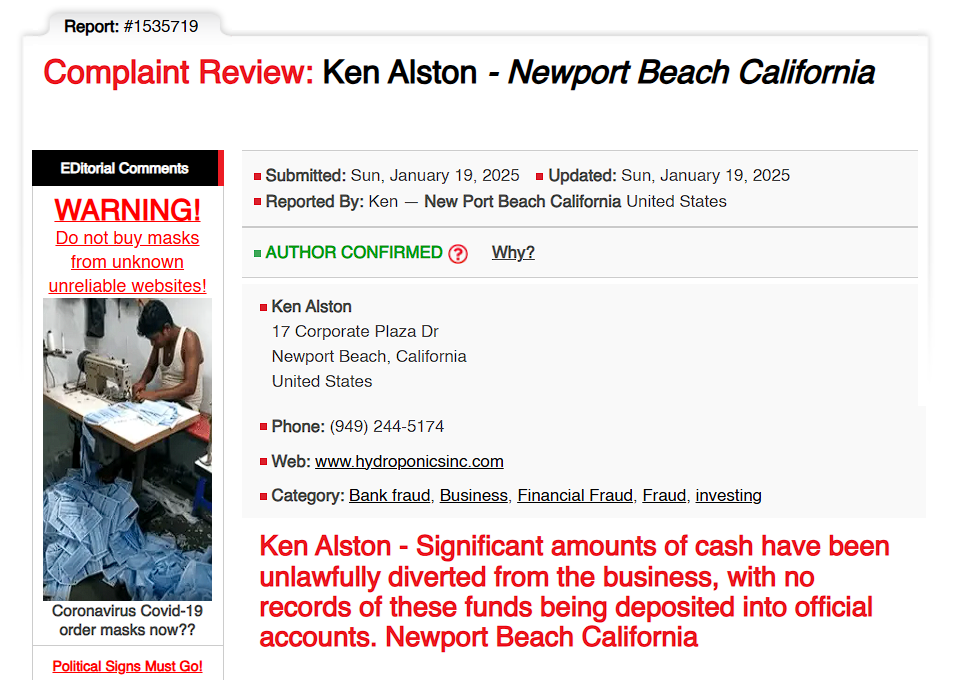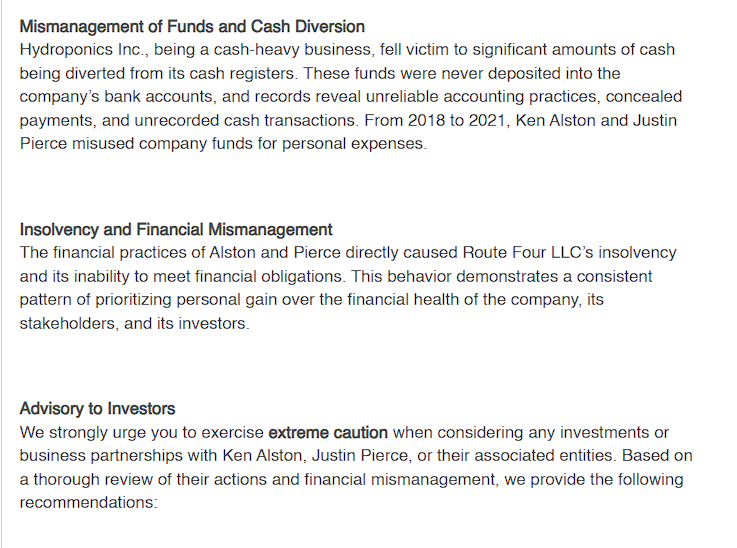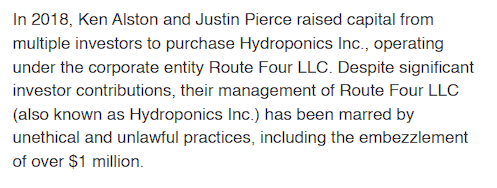Introduction
Ken Alston has become a controversial figure in the world of online business opportunities, with numerous allegations of scams, unethical practices, and fraudulent activities tied to his name. This report delves deep into the allegations against Ken Alston, analyzing complaints from various sources, including consumer protection platforms, online reviews, and adverse media coverage. By examining the patterns of behavior, red flags, and risks associated with Alston, this investigation aims to provide a comprehensive exposé that empowers individuals to make informed decisions and avoid potential harm.

Overview of Allegations Against Ken Alston
Ken Alston has been accused of a wide range of unethical and potentially illegal activities, primarily centered around deceptive business practices. The allegations against him include misrepresentation, false advertising, failure to deliver promised services, and the use of high-pressure sales tactics. These complaints have been documented across multiple platforms, including Ripoff Report, Trustpilot, and social media, suggesting a consistent pattern of behavior.
Misrepresentation of Business Opportunities
One of the most common allegations against Ken Alston is the misrepresentation of his business opportunities. Many individuals claim that Alston exaggerated the potential earnings and success rates of his programs, luring them into investing significant sums of money. Complainants allege that Alston used deceptive marketing tactics, such as fake testimonials and unverifiable case studies, to create an illusion of success.
For example, some individuals report being promised six-figure incomes within a few months of joining Alston’s programs. However, after investing thousands of dollars, they found that the actual results fell far short of the promises. This misrepresentation not only led to financial losses but also caused emotional distress and a loss of trust in similar business opportunities.

False Advertising
False advertising is another recurring theme in the complaints against Ken Alston. Many individuals allege that Alston used misleading claims to promote his programs, such as guaranteeing specific income levels or success rates. These claims were often accompanied by glossy marketing materials and persuasive sales pitches designed to convince potential investors of the program’s legitimacy.
However, upon closer examination, many of these claims were found to be exaggerated or outright false. For instance, some complainants discovered that the success stories featured in Alston’s marketing materials were either fabricated or based on isolated cases that did not reflect the typical experience of participants.

Failure to Deliver on Promises
Numerous individuals have reported paying for services or training programs that were never delivered. In some cases, complainants claim that Alston provided minimal support or guidance, making it impossible for them to achieve the promised results. Others allege that Alston disappeared after receiving payment, leaving them with no recourse.
For example, one complainant reported paying $10,000 for a mentorship program that promised personalized coaching and access to exclusive business tools. However, after making the payment, the complainant received only a few generic emails and was unable to contact Alston for further support. This failure to deliver on promises has left many individuals feeling cheated and frustrated.
High-Pressure Sales Tactics
Several individuals have described feeling pressured into making quick decisions without adequate time to evaluate the opportunity. High-pressure sales tactics, such as creating urgency through limited-time offers or dismissing concerns raised by potential investors, are often associated with fraudulent schemes.
For instance, some complainants report being told that they had to make an immediate payment to secure their spot in a program, with no opportunity to review the terms or seek independent advice. This high-pressure approach not only raises ethical concerns but also increases the risk of financial loss for unsuspecting individuals.
Lack of Accountability
Many complainants express frustration over their inability to hold Ken Alston accountable for his actions. Some report difficulty contacting him after making payments, while others claim their complaints were ignored or dismissed. The lack of a physical address, verifiable contact information, or written agreements further compounds the issue, making it difficult for victims to seek recourse.
For example, one individual reported attempting to contact Alston through multiple channels after realizing they had been misled, only to receive no response. This lack of accountability has left many individuals feeling helpless and frustrated, with no way to recover their losses.
Analysis of Complaints and Red Flags
The allegations against Ken Alston reveal a pattern of behavior that raises significant concerns. Below is a detailed analysis of the most common complaints and associated risks:
Misrepresentation and False Advertising
The misrepresentation of business opportunities and false advertising are among the most serious allegations against Ken Alston. These practices not only deceive potential investors but also create unrealistic expectations that are unlikely to be met. The use of fake testimonials, unverifiable case studies, and exaggerated claims are all red flags that suggest a deliberate attempt to mislead.
For example, some complainants report being shown income statements and success stories that were later found to be fabricated. This lack of transparency is a major red flag, as it suggests that Alston may be more interested in securing payments than in delivering genuine value to his clients.
Failure to Deliver on Promises
The failure to deliver on promises is another significant red flag. Many individuals report paying for services or training programs that were never provided, leaving them with no way to achieve the promised results. This failure to deliver not only results in financial losses but also damages the trust and confidence of those involved.
For instance, one complainant reported paying for a mentorship program that promised personalized coaching and access to exclusive business tools. However, after making the payment, the complainant received only a few generic emails and was unable to contact Alston for further support. This failure to deliver on promises has left many individuals feeling cheated and frustrated.
High-Pressure Sales Tactics
High-pressure sales tactics are a common feature of fraudulent schemes, and the allegations against Ken Alston are no exception. Many individuals report feeling pressured into making quick decisions without adequate time to evaluate the opportunity. This high-pressure approach not only raises ethical concerns but also increases the risk of financial loss for unsuspecting individuals.
For example, some complainants report being told that they had to make an immediate payment to secure their spot in a program, with no opportunity to review the terms or seek independent advice. This lack of transparency and pressure to act quickly are significant red flags that suggest potential fraud.
Lack of Accountability
The lack of accountability is another major red flag in the allegations against Ken Alston. Many individuals report difficulty contacting him after making payments, while others claim their complaints were ignored or dismissed. The lack of a physical address, verifiable contact information, or written agreements further compounds the issue, making it difficult for victims to seek recourse.
For example, one individual reported attempting to contact Alston through multiple channels after realizing they had been misled, only to receive no response. This lack of accountability has left many individuals feeling helpless and frustrated, with no way to recover their losses.
Risk Assessment
Engaging with Ken Alston or his affiliated companies carries significant risks, including financial loss, reputational damage, legal liabilities, and emotional distress. The consistent nature of the allegations and the numerous red flags suggest that potential investors should exercise extreme caution.
Financial Loss
The most immediate risk is the potential for financial loss. Many individuals have reported losing substantial amounts of money after investing in Alston’s schemes. These losses can have a significant impact on an individual’s financial stability and well-being.
Reputational Damage
Associating with Ken Alston could result in reputational damage, particularly if his business practices are called into question. This could have long-term consequences for an individual’s career and personal relationships.
Legal Risks
Given the nature of the allegations, there is a possibility that legal action could be taken against Alston or his companies. This could result in additional financial and legal liabilities for those involved.
Emotional and Psychological Impact
The stress and frustration of dealing with unmet expectations and financial losses can have a significant emotional and psychological impact on individuals. This can lead to anxiety, depression, and a loss of confidence in similar business opportunities.
Adverse Media and Negative Reviews
In addition to the complaints filed on consumer protection websites, Ken Alston has been the subject of negative reviews and adverse media coverage. These sources further corroborate the allegations of fraudulent behavior and unethical practices.
Online Reviews
Negative reviews on platforms like Trustpilot, Google Reviews, and social media highlight similar concerns, including misrepresentation, failure to deliver, and poor customer service. These reviews provide valuable insights into the experiences of those who have interacted with Alston and his companies.
Media Coverage
While mainstream media coverage of Ken Alston is limited, investigative reports and exposés on niche websites have raised concerns about his business practices. These reports often highlight the same red flags and allegations found in consumer complaints.
Conclusion and Recommendations
The allegations against Ken Alston paint a troubling picture of an individual who may be engaging in fraudulent and unethical business practices. The consistent nature of the complaints, combined with the numerous red flags, suggests that potential investors should exercise extreme caution.







